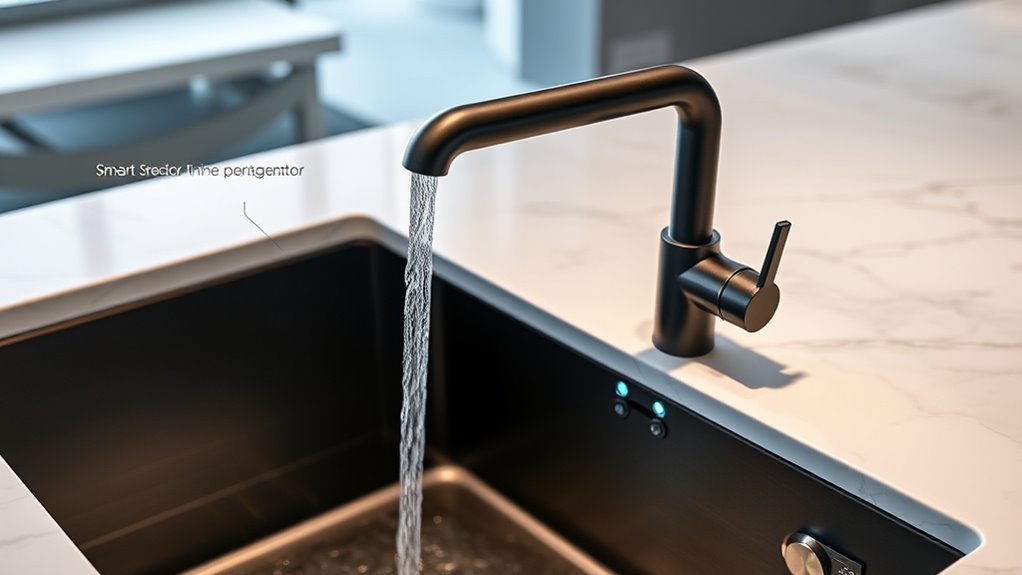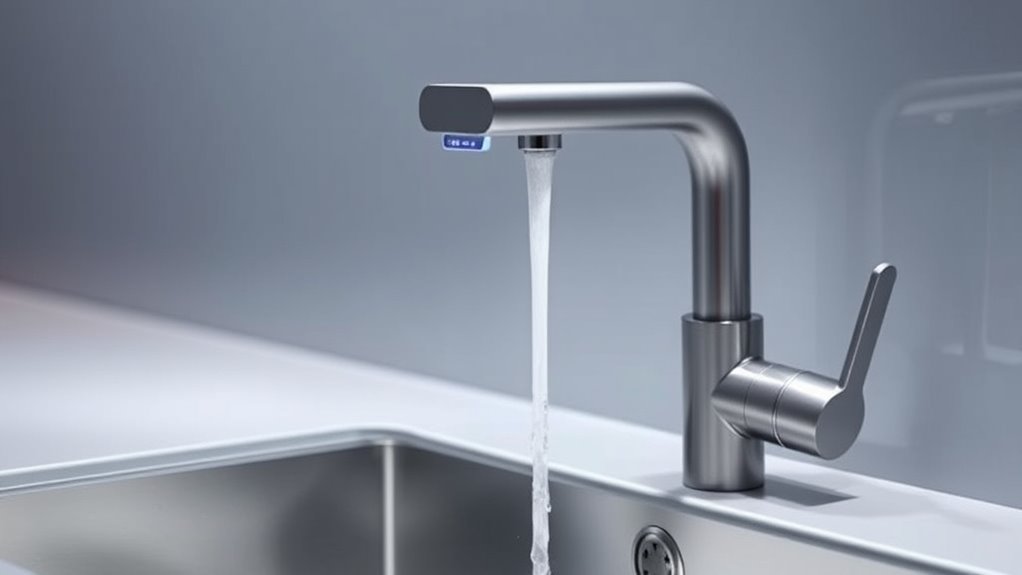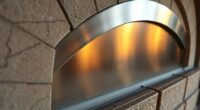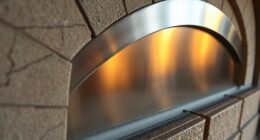Smart faucets help conserve water by automatically sensing your presence and releasing only the exact amount you need. They shut off instantly when you step away, preventing leaks and unnecessary flow. Many models allow you to adjust flow rates or activate eco modes to further reduce usage. With these features, you’ll waste less water and save on utility bills. Keep exploring to discover even more ways smart faucets make your kitchen greener and more efficient.
Key Takeaways
- Detects presence automatically, activating water flow only when needed, preventing unnecessary water use.
- Features adjustable flow rates and eco-modes to limit water volume during each use.
- Shuts off instantly when hands leave, avoiding drips and leaks that waste water.
- Monitors and reports water consumption via smartphone apps for better conservation habits.
- Reduces energy used for heating and pumping by minimizing overall water usage.

Smart faucets are transforming how we conserve water by integrating technology that automatically detects usage and adjusts flow accordingly. When you walk up to the sink, sensor technology activates the faucet instantly, eliminating the need to turn handles or knobs. This hands-free operation not only promotes hygiene but also guarantees water isn’t wasted when you forget to turn off the tap. With precise sensing, the faucet releases just the right amount of water you need, reducing excess flow and preventing unnecessary waste. As you finish, the sensor detects your presence leaving the area and stops the flow immediately, avoiding drips or leaks that often happen with traditional faucets. This seamless automation encourages mindful water use without sacrificing convenience.
Smart faucets use sensors to automatically control water flow, reducing waste and enhancing hygiene with hands-free operation.
These smart faucets come equipped with water saving features that make a noticeable difference in your daily routine. For example, many models include adjustable flow rates, allowing you to set a maximum limit so the water never exceeds a certain volume. This means you’re actively controlling how much water is used during each use, which is especially valuable during busy mornings or when cooking. Additionally, some faucets have eco-friendly modes that further reduce flow, helping you cut down on water consumption without compromising function. These features work together to create a system that’s both efficient and environmentally responsible. You’ll find that the combination of sensor technology and water saving features encourages you to be more conscious of your water habits, naturally leading to less waste.
Beyond just saving water, smart faucets also help you save money on your utility bills. Less water used means less energy required to heat and pump water, translating into lower costs over time. Plus, since these faucets minimize leaks and drips through their automatic shut-off capabilities, you’re less likely to waste water unknowingly. The convenience of touchless operation also reduces the need for cleaning around handles or knobs, keeping your sink area cleaner and more hygienic. Many models even come with smart features that allow you to monitor water usage via a smartphone app, giving you insights into your consumption habits and helping you make adjustments to conserve even more. Interestingly, advancements in projector technology are paving the way for even more innovative ways to display and enjoy visual content at home.
In short, by embracing sensor technology and water saving features, you transform your kitchen into a more efficient space. Smart faucets make conserving water simple, intuitive, and effective—empowering you to reduce waste effortlessly while enjoying the modern comforts of automated technology.
Frequently Asked Questions
Do Smart Faucets Require Special Plumbing Installation?
Smart faucets generally don’t require special plumbing installation, but you should check specific models’ installation requirements. They connect to your existing water supply and often have simple setup steps. By ensuring proper installation, you can maximize their water conservation benefits. Some models may need minor adjustments, but most are designed for compatibility with standard plumbing. So, upgrading is usually straightforward, helping you save water without complicated or costly modifications.
Are Smart Faucets Compatible With Existing Kitchen Fixtures?
A stitch in time saves nine, and your smart faucet easily fits into your existing fixtures. They’re designed for sensor compatibility and fixture integration, so you won’t need special plumbing. You can upgrade your kitchen effortlessly, as most models are compatible with standard setups. Just double-check your specific faucet’s specifications, and you’ll enjoy smart, water-saving convenience without the hassle of major modifications.
How Much Do Smart Faucets Typically Cost?
Smart faucets typically cost between $150 and $500, depending on features and brand. When doing a cost comparison, consider pricing factors like advanced technology, touchless operation, and compatibility with your existing fixtures. While they may seem pricey upfront, many users find the water savings and convenience justify the investment. Keep in mind that installation costs and warranties can also influence the overall price, making it worth shopping around.
Can Smart Faucets Be Used Without Wi-Fi?
You might think smart faucets are entirely dependent on Wi-Fi, but surprisingly, many can operate without it. While wireless connectivity offers remote control and app features, basic functions like turning water on and off often work with plumbing compatibility alone. So, if your Wi-Fi drops, your smart faucet can still serve you — just don’t expect all the fancy features to work without that invisible internet connection.
What Maintenance Do Smart Faucets Need Over Time?
You’ll need to regularly check your smart faucet’s sensor calibration to guarantee it responds accurately. Additionally, if your model runs on batteries, replace them as needed to avoid interruptions. Keep the aerator clean to prevent clogs, and periodically inspect the connections for leaks. Maintaining these simple tasks helps your smart faucet function efficiently, conserving water and extending its lifespan. Regular upkeep ensures you enjoy seamless, eco-friendly operation over time.
Conclusion
Smart faucets seamlessly save water while simplifying your sink time. By blending brilliance with basic needs, they bring beauty to your bathroom and kitchen routines. With clever controls and consistent conservation, you can confidently curb waste without compromising convenience. So, make the switch, save water, and stay sustainable—because small steps in your space can make a significant, sustainable splash in the world.









